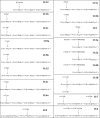Genetics and evolution of Yersinia pseudotuberculosis O-specific polysaccharides: a novel pattern of O-antigen diversity
- PMID: 28364730
- PMCID: PMC5399914
- DOI: 10.1093/femsre/fux002
Genetics and evolution of Yersinia pseudotuberculosis O-specific polysaccharides: a novel pattern of O-antigen diversity
Abstract
O-antigen polysaccharide is a major immunogenic feature of the lipopolysaccharide of Gram-negative bacteria, and most species produce a large variety of forms that differ substantially from one another. There are 18 known O-antigen forms in the Yersinia pseudotuberculosis complex, which are typical in being composed of multiple copies of a short oligosaccharide called an O unit. The O-antigen gene clusters are located between the hemH and gsk genes, and are atypical as 15 of them are closely related, each having one of five downstream gene modules for alternative main-chain synthesis, and one of seven upstream modules for alternative side-branch sugar synthesis. As a result, many of the genes are in more than one gene cluster. The gene order in each module is such that, in general, the earlier a gene product functions in O-unit synthesis, the closer the gene is to the 5΄ end for side-branch modules or the 3΄ end for main-chain modules. We propose a model whereby natural selection could generate the observed pattern in gene order, a pattern that has also been observed in other species.
Keywords: O antigen; O-specific polysaccharide; Yersinia pseudotuberculosis; gene cluster; lipopolysaccharide; serotype.
© FEMS 2017.
Figures









Similar articles
-
Characterization of the O-antigen gene clusters of Yersinia pseudotuberculosis and the cryptic O-antigen gene cluster of Yersinia pestis shows that the plague bacillus is most closely related to and has evolved from Y. pseudotuberculosis serotype O:1b.Mol Microbiol. 2000 Jul;37(2):316-30. doi: 10.1046/j.1365-2958.2000.01993.x. Mol Microbiol. 2000. PMID: 10931327
-
Characterization of the specific O-polysaccharide structure and biosynthetic gene cluster of Yersinia pseudotuberculosis serotype O:15.Innate Immun. 2009 Dec;15(6):351-9. doi: 10.1177/1753425909105319. Innate Immun. 2009. PMID: 19723831
-
Genetic analysis of the O-antigen gene clusters of Yersinia pseudotuberculosis O:6 and O:7.Glycobiology. 2011 Sep;21(9):1140-6. doi: 10.1093/glycob/cwr010. Epub 2011 Feb 16. Glycobiology. 2011. PMID: 21325338
-
The biosynthesis and biological role of lipopolysaccharide O-antigens of pathogenic Yersiniae.Carbohydr Res. 2003 Nov 14;338(23):2521-9. doi: 10.1016/s0008-6215(03)00305-7. Carbohydr Res. 2003. PMID: 14670713 Review.
-
Yersinia enterocolitica lipopolysaccharide: genetics and virulence.Trends Microbiol. 1993 Jul;1(4):148-52. doi: 10.1016/0966-842x(93)90130-j. Trends Microbiol. 1993. PMID: 7511477 Review.
Cited by
-
Genomic Epidemiology and Phenotyping Reveal on-Farm Persistence and Cold Adaptation of Raw Milk Outbreak-Associated Yersinia pseudotuberculosis.Front Microbiol. 2019 May 14;10:1049. doi: 10.3389/fmicb.2019.01049. eCollection 2019. Front Microbiol. 2019. PMID: 31156582 Free PMC article.
-
Elastic Light Scatter Pattern Analysis for the Expedited Detection of Yersinia Species in Pork Mince: Proof of Concept.Front Microbiol. 2021 Feb 17;12:641801. doi: 10.3389/fmicb.2021.641801. eCollection 2021. Front Microbiol. 2021. PMID: 33679677 Free PMC article.
-
Structure and genetics of Escherichia coli O antigens.FEMS Microbiol Rev. 2020 Nov 24;44(6):655-683. doi: 10.1093/femsre/fuz028. FEMS Microbiol Rev. 2020. PMID: 31778182 Free PMC article. Review.
-
Diversity of sugar-diphospholipid-utilizing glycosyltransferase families.Commun Biol. 2024 Mar 7;7(1):285. doi: 10.1038/s42003-024-05930-2. Commun Biol. 2024. PMID: 38454040 Free PMC article.
-
Large diversity in the O-chain biosynthetic cluster within populations of Pelagibacterales.mBio. 2025 Mar 12;16(3):e0345524. doi: 10.1128/mbio.03455-24. Epub 2025 Feb 19. mBio. 2025. PMID: 39969192 Free PMC article.
References
-
- Alam J, Beyer N, Liu HW. Biosynthesis of colitose: expression, purification, and mechanistic characterization of GDP-4-keto-6-deoxymannose-3-dehydrase (ColD) and GDP-l-coltiose synthase (ColC). Biochemistry 2004;43:16450–60. - PubMed
-
- Aleksic S, Suchan G, Bockemühl J et al. . An extended antigenic scheme for Yersinia pseudotuberculosis. In: Une T, Maruyama T, Tsubokura M (eds). Contributions to Microbiology and Immunology; Current Investigations of the Microbiology of Yersiniae. Basel, Switzerland: Karger, 1991, 235–8. - PubMed
Publication types
MeSH terms
Substances
LinkOut - more resources
Full Text Sources
Other Literature Sources
Research Materials

